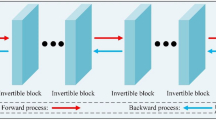Abstract
Accurate dose map prediction is key to external radiotherapy. Previous methods have achieved promising results; however, most of these methods learn the dose map as a black box without considering the beam-shaped radiation for treatment delivery in clinical practice. The accuracy is usually limited, especially on beam paths. To address this problem, this paper describes a novel “disassembling-then-assembling" strategy to consider the dose prediction task from the nature of radiotherapy. Specifically, a global-to-beam network is designed to first predict dose values of the whole image space and then utilize the proposed innovative beam masks to decompose the dose map into multiple beam-based sub-fractions in a beam-wise manner. This can disassemble the difficult task to a few easy-to-learn tasks. Furthermore, to better capture the dose distribution in region-of-interest (ROI), we introduce two novel value-based and criteria-based dose volume histogram (DVH) losses to supervise the framework. Experimental results on the public OpenKBP challenge dataset show that our method outperforms the state-of-the-art methods, especially on beam paths, creating a trustable and interpretable AI solution for radiotherapy treatment planning. Our code is available at https://github.com/ukaukaaaa/BeamDosePrediction.
B. Wang and L. Teng—Equal Contribution
Access this chapter
Tax calculation will be finalised at checkout
Purchases are for personal use only
Similar content being viewed by others
References
Babier, A., et al.: OpenKBP: the open-access knowledge-based planning grand challenge and dataset. Med. Phys. 48(9), 5549–5561 (2021)
Dias, J., Rocha, H., Ferreira, B., do Carmo Lopes, M.: Simulated annealing applied to IMRT beam angle optimization: a computational study. Physica Medica 31(7), 747–756 (2015)
Gronberg, M.P., Gay, S.S., Netherton, T.J., Rhee, D.J., Court, L.E., Cardenas, C.E.: Dose prediction for head and neck radiotherapy using a three-dimensional dense dilated u-net architecture. Med. Phys. 48(9), 5567–5573 (2021)
Kearney, V., Chan, J.W., Valdes, G., Solberg, T.D., Yom, S.S.: The application of artificial intelligence in the IMRT planning process for head and neck cancer. Oral Oncol. 87, 111–116 (2018)
Lin, Y., Liu, Y., Liu, J., Liu, G., Ma, K., Zheng, Y.: LE-NAS: learning-based ensemble with NAS for dose prediction. arXiv preprint arXiv:2106.06733 (2021)
Liu, S., Zhang, J., Li, T., Yan, H., Liu, J.: A cascade 3D U-Net for dose prediction in radiotherapy. Med. Phys. 48(9), 5574–5582 (2021)
Men, C., Romeijn, H.E., Taşkın, Z.C., Dempsey, J.F.: An exact approach to direct aperture optimization in IMRT treatment planning. Phys. Med. Biol. 52(24), 7333 (2007)
Milletari, F., Navab, N., Ahmadi, S.A.: V-Net: fully convolutional neural networks for volumetric medical image segmentation. In: 2016 Fourth International Conference on 3D Vision (3DV), pp. 565–571. IEEE (2016)
Nguyen, D., et al.: 3D radiotherapy dose prediction on head and neck cancer patients with a hierarchically densely connected u-net deep learning architecture. Phys. Med. Biol. 64(6), 065020 (2019)
Nguyen, D., et al.: Incorporating human and learned domain knowledge into training deep neural networks: a differentiable dose-volume histogram and adversarial inspired framework for generating pareto optimal dose distributions in radiation therapy. Med. Phys. 47(3), 837–849 (2020)
Pan, Y., Liu, M., Lian, C., Zhou, T., Xia, Y., Shen, D.: Synthesizing missing PET from MRI with cycle-consistent generative adversarial networks for Alzheimer’s disease diagnosis. In: Frangi, A.F., Schnabel, J.A., Davatzikos, C., Alberola-López, C., Fichtinger, G. (eds.) MICCAI 2018. LNCS, vol. 11072, pp. 455–463. Springer, Cham (2018). https://doi.org/10.1007/978-3-030-00931-1_52
Tan, S., et al.: Incorporating isodose lines and gradient information via multi-task learning for dose prediction in radiotherapy. In: de Bruijne, M., et al. (eds.) MICCAI 2021. LNCS, vol. 12907, pp. 753–763. Springer, Cham (2021). https://doi.org/10.1007/978-3-030-87234-2_71
Xiang, L., et al.: Deep embedding convolutional neural network for synthesizing CT image from t1-weighted MR image. Med. Image Anal. 47, 31–44 (2018)
Xu, X., et al.: Prediction of optimal dosimetry for intensity-modulated radiotherapy with a cascaded auto-content deep learning model. Int. J. Radiat. Oncol. Biol. Phys. 111(3), e113 (2021)
Zhang, J., Liu, S., Yan, H., Li, T., Mao, R., Liu, J.: Predicting voxel-level dose distributions for esophageal radiotherapy using densely connected network with dilated convolutions. Phys. Med. Biol. 65(20), 205013 (2020)
Zimmermann, L., Faustmann, E., Ramsl, C., Georg, D., Heilemann, G.: Dose prediction for radiation therapy using feature-based losses and one cycle learning. Med. Phys. 48(9), 5562–5566 (2021)
Author information
Authors and Affiliations
Corresponding authors
Editor information
Editors and Affiliations
Rights and permissions
Copyright information
© 2022 The Author(s), under exclusive license to Springer Nature Switzerland AG
About this paper
Cite this paper
Wang, B. et al. (2022). Deep Learning-Based Head and Neck Radiotherapy Planning Dose Prediction via Beam-Wise Dose Decomposition. In: Wang, L., Dou, Q., Fletcher, P.T., Speidel, S., Li, S. (eds) Medical Image Computing and Computer Assisted Intervention – MICCAI 2022. MICCAI 2022. Lecture Notes in Computer Science, vol 13437. Springer, Cham. https://doi.org/10.1007/978-3-031-16449-1_55
Download citation
DOI: https://doi.org/10.1007/978-3-031-16449-1_55
Published:
Publisher Name: Springer, Cham
Print ISBN: 978-3-031-16448-4
Online ISBN: 978-3-031-16449-1
eBook Packages: Computer ScienceComputer Science (R0)





